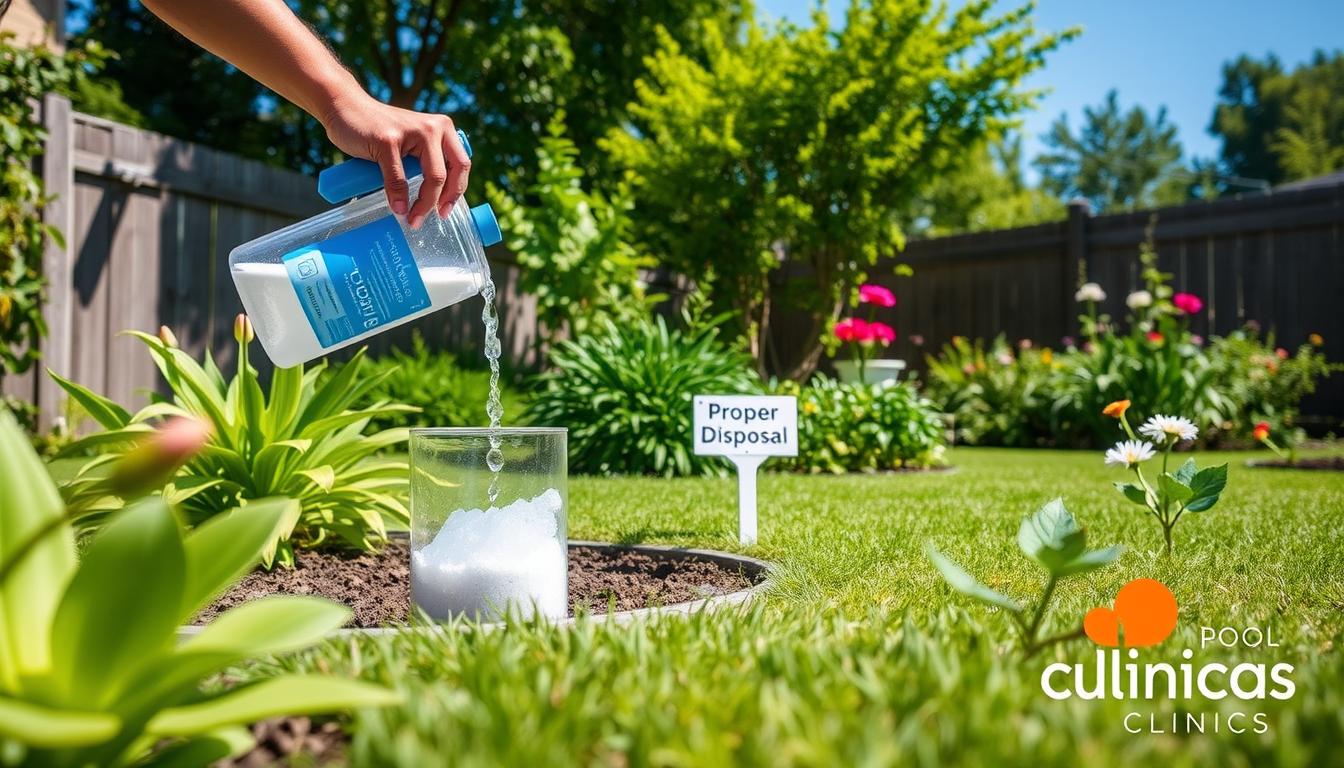
Disposing of Epsom salt water correctly is crucial for environmental protection. Magnesium sulfate, the main ingredient in Epsom salts, has many uses. It soothes sore muscles and nourishes plants.
Improper disposal can harm ecosystems. By following safe guidelines, we can minimize our environmental impact. This allows us to enjoy Epsom salt’s benefits while protecting nature.
This guide will teach you how to dissolve Epsom salt in water safely. You’ll learn to pour the solution down the drain correctly. We’ll also explore eco-friendly alternatives for disposal.
Using Epsom salt as garden fertilizer is one option. Another is creating DIY bath salt mixtures. Composting it sparingly can work too.
By the end, you’ll know how to dispose of Epsom salt water responsibly. You’ll also learn to follow local regulations for proper disposal.
Key Takeaways
- Follow safe epsom salt water disposal guidelines to minimize environmental impact
- Dissolve Epsom salt in warm water and pour the solution down the drain carefully
- Explore eco-friendly disposal methods like using Epsom salt as a garden fertilizer or in DIY bath salts
- Compost Epsom salt sparingly to avoid disrupting the composting process
- Donate or exchange unused Epsom salt to reduce waste
- Always adhere to local epsom salt water disposal regulations and guidelines
Dissolving Epsom Salt in Water
Dissolving Epsom salt in water is a simple, eco-friendly disposal method. This approach works best for small amounts of Epsom salt. It protects your plumbing and the environment when done correctly.

Filling a Container with Warm Water
Start by filling a clean container with warm water. The warmth helps the salt dissolve faster. Choose a container big enough for your Epsom salt and stirring.
Gradually Adding Epsom Salt while Stirring
Add the Epsom salt to the warm water slowly. Stir constantly to prevent clumping. Use a spoon or stirring rod for thorough mixing.
Keep adding and stirring until all salt is dissolved. This ensures even distribution in the water.
| Amount of Epsom Salt | Water Required for Dissolution |
|---|---|
| 1 cup (200 g) | 1 gallon (3.8 L) |
| 1/2 cup (100 g) | 1/2 gallon (1.9 L) |
| 1/4 cup (50 g) | 1 quart (0.95 L) |
Safely Pouring the Dissolved Solution Down the Drain
Once fully dissolved, pour the solution down the drain slowly. Make sure all crystals are dissolved to avoid plumbing issues. Pour steadily to prevent splashing or spilling.
To protect your plumbing and the environment, follow these epsom salt water disposal tips:
- Avoid pouring large amounts at once to prevent strain on plumbing systems.
- Dispose of large quantities in smaller batches over time.
- Clean drains regularly to prevent Epsom salt residue buildup.
By following these steps and precautions, you’ll protect the environment and your home’s plumbing system.
Innovative and Eco-Friendly Disposal Methods
Epsom salt water disposal often involves pouring it down the drain. However, there are eco-friendly alternatives to consider. These methods can minimize our environmental impact and make the most of this versatile compound.
Using Epsom Salt as Garden and Plant Fertilizer
Epsom salt can nourish your garden or houseplants. It contains magnesium and sulfur, which are essential for plant growth. Mix a small amount with water and apply it to the soil around your plants.
This method reduces waste and promotes healthy plant development. It’s an eco-friendly way to use up your leftover Epsom salt.
Repurposing Epsom Salt for DIY Bath Salt Mixtures
Create your own bath salt mixtures with larger quantities of Epsom salt. Combine it with sea salt, baking soda, and essential oils. This creates a luxurious and therapeutic bath experience.
You’ll enjoy the benefits of Epsom salt while minimizing waste. It’s a great way to embrace eco-friendly practices.
Composting Epsom Salt Sparingly
Composting Epsom salt can be a viable option for the environmentally conscious. When added in small amounts, it can enhance the decomposition process. It also provides essential nutrients to the resulting soil amendment.
Use Epsom salt sparingly in compost. Excessive amounts can disrupt the delicate balance of the composting ecosystem.
Donating or Exchanging Unused Epsom Salt
Consider donating unused Epsom salt to local community gardens, schools, or organizations. You can also explore online platforms where individuals exchange or trade items. This supports others in your community while practicing sustainable disposal methods.
| Disposal Method | Benefits |
|---|---|
| Garden and Plant Fertilizer | Nourishes plants with magnesium and sulfur |
| DIY Bath Salt Mixtures | Creates luxurious and therapeutic bath experiences |
| Composting | Enhances decomposition and provides nutrients to soil |
| Donating or Exchanging | Supports community and promotes sustainable practices |
These eco-friendly Epsom salt disposal methods help minimize our environmental impact. We can use it as plant fertilizer, repurpose it for DIY projects, or compost it responsibly. Donating it to others also contributes to a greener future.
Conclusion
Proper Epsom salt water disposal is vital for a healthy environment. There are eco-friendly methods to use Epsom salt responsibly. These include using it as fertilizer, making DIY bath salts, and composting sparingly.
When disposing of Epsom salt water, follow local rules. Dissolve the salt in water before pouring it down the drain. This protects septic systems and natural water sources.
Responsible disposal helps maintain a clean living space. It also allows us to enjoy Epsom salt’s benefits fully. These include soothing muscles, reducing stress, and nourishing plants.







